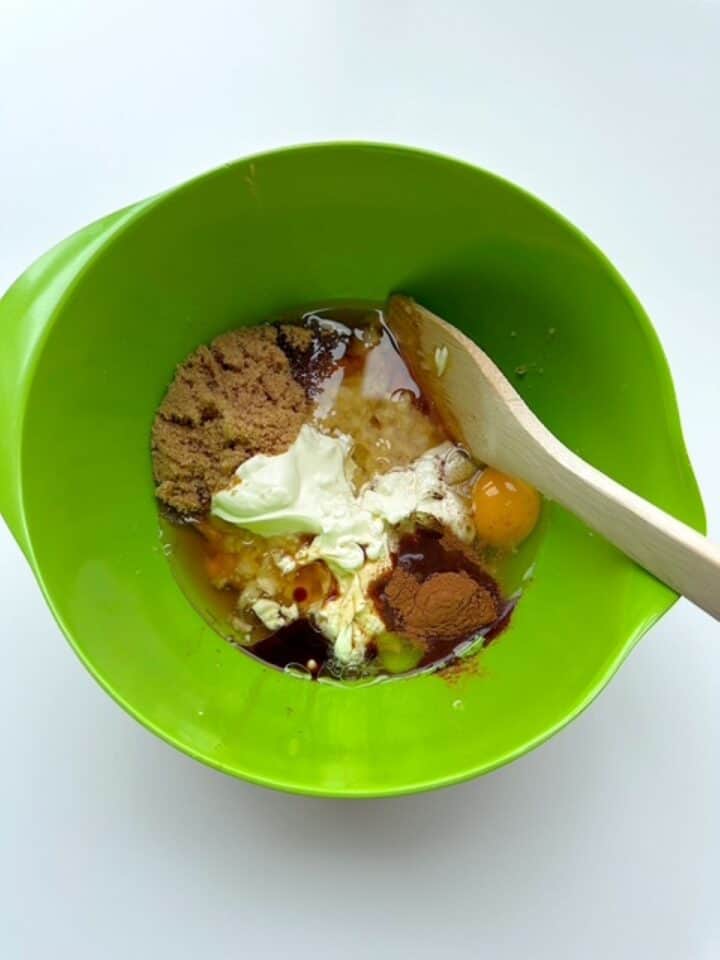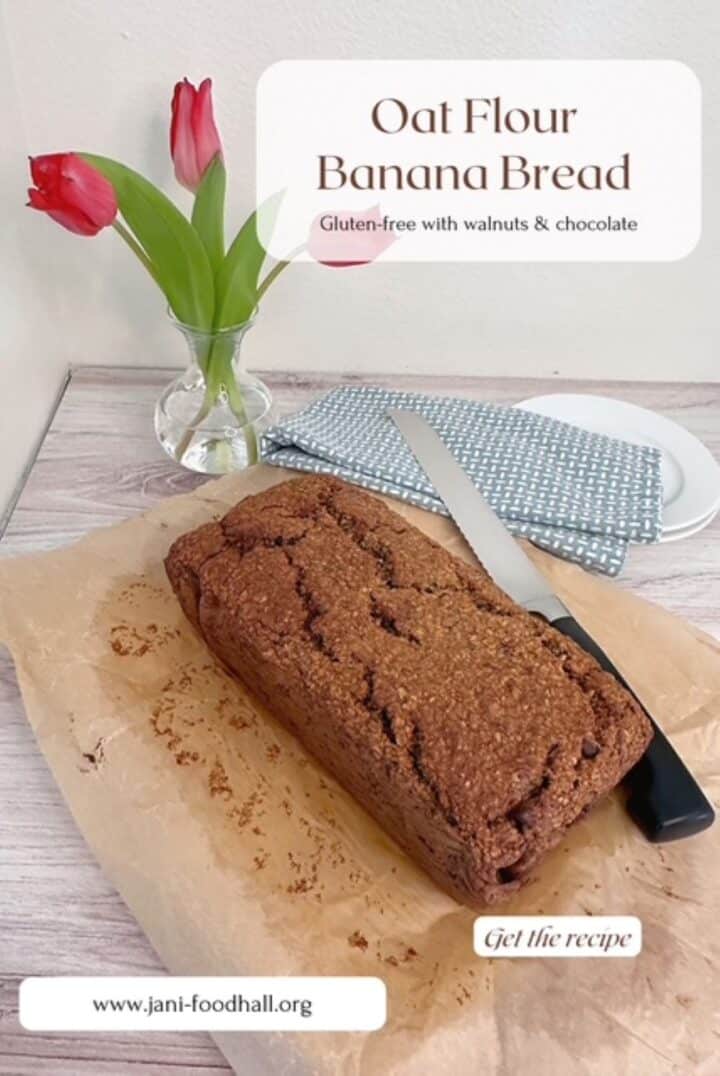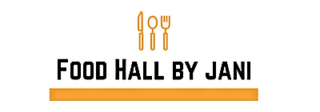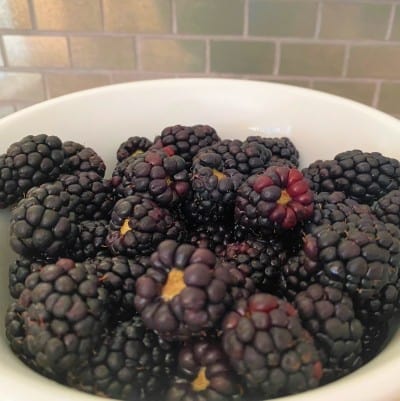Oat Flour Banana Bread makes a tasty breakfast, snack, or even dessert, especially with added goodies like mini chocolate chips and toasted walnuts.
Blitzing oats in your food processor or blender makes it easy to put them to work as nutritious, gluten-free flour.
This recipe is perfect for heart health. The combo of oat flour and sweet bananas helps the loaf bake up tender, and moist even though it has only a small amount of oil.

Would you like to save this recipe or article?
You won't get spam from me, I promise!
I earn from qualifying purchases at no extra cost to you as part of the Amazon Affiliate program.
Ingredients

- Whole rolled oats (oatmeal)
- Cinnamon
- Baking soda
- Baking powder
- Salt
- Bananas
- Plain Greek yogurt
- Vegetable oil
- Maple syrup
- Brown stevia or monkfruit sweetener (optional)
- Egg
- Vanilla
Extras

- Chopped walnuts (optional)
- Chocolate chips (optional)
Whole, rolled oats (oatmeal): Whole rolled oats, rather than instant or steel-cut, are necessary to make the oat flour for the bread. If you have a bag of (affiliate link) oat flour, feel free to swap in one and three-quarters cups for the oats.
Cinnamon: Many brands contain high levels of lead. This is especially concerning for children. Per testing from Consumer Reports, lower levels are found in cinnamon from (affiliate link) Morton and Bassett San Francisco Organic Spices or Whole Foods 365 Organic.
🍌Bananas: Put your overripe bananas to use here! You can also use any that are in the freezer. Greener bananas will not work in this recipe.
Plain Greek yogurt: You can choose whole milk, 2%, or even, nonfat. The nutrition calculations are for 2% yogurt.
Vegetable oil: Choose an oil with plenty of monounsaturated or polyunsaturated fats to keep the loaf heart healthy, such as olive oil, canola oil, and sunflower oil. Butter and coconut oil are not recommended because they have higher levels of saturated fat.
🍁Maple syrup: Although it is just as high in added sugar as the refined, granulated stuff, it does have a terrific flavor and a few minerals.
Brown stevia or monkfruit sweetener: In combination with the syrup, the taste of this no-carb, no-calorie sweetener is undetectable. However, it makes the bread taste sweeter and adds a "brown sugar" vibe. You can sub in regular brown sugar.
🥚Egg: For vegan baking, swap in a flax egg by combining three Tablespoons of ground flax seed with one to two Tablespoons of water. Let the flax-water egg sit for at least three minutes.
How to Make
Wash your hands, lathering with soap and rinsing with running water for 20 seconds, before starting.

1️⃣Process the whole oats in a food processor until they have a fine texture.
Add the baking soda, baking powder, and salt to the processor bowl and pulse to combine.

2️⃣Mash the bananas in a large bowl.

4️⃣Add the yogurt, oil, maple syrup, brown sweetener (or sugar), egg, and vanilla.

Mix together with a spatula or whisk until the consistency is even.

5️⃣Pour the dry ingredients over the top of the wet ingredients.

Lightly mix them in until they are just moistened.

6️⃣If desired, add nuts, chocolate chips, or another favorite addition (like raisins or dates).
7️⃣Pour into a prepared pan and bake until a toothpick inserted in the center comes out with no crumbs attached.

8️⃣Let cool on a rack for five to 10 minutes. Remove from pan and let the loaf cool and firm up for about 10 more minutes before slicing.
Variations
With chopped walnuts and chocolate chips added to the batter, the taste will remind you of an oatmeal chocolate chip cookie. Those extras plump the bread with 60 calories, 10 grams of carbs, and five grams of (healthy) fats per serving (slice).
But there are many other marvelous additions to choose from.
- Craisins
- Chopped Dates
- Raisins (oatmeal raisin cookie, anyone?)
- Coconut
- Pecans
- Almonds
- Dark chocolate chunks, or milk chocolate chips
Of course, you don't need to add anything. This bread is delicious and hearty on its own.
Baking and serving tips
Overmixing is the enemy of moist, tender, toothsome bread.
Making your flour from oats will help keep the bread less dense. The commercially milled (affiliate link) oat flour is convenient, though.
🍴Because the finished bread gets its structure from oats, which have no gluten, it is more fragile than many other breads and will tend to fall apart easily. Enjoy it with a fork, if necessary.

🧊Storage
Oat flour bread is no different than other baked goods when it comes to storage and freezing.
You can wrap it in foil and place inside a large zip bag and leave it at room temperature for a couple of days. After that, it should go into the fridge or freezer.
It will keep frozen for at least three months. After this amount of time, the quality and taste may deteriorate.
Is this bread healthy?
It is a healthy bread for breakfast, snack, or even dessert if you decide to use some chocolate chips in it.
Oats are a well-rounded morsel of nourishment and contain a nice mix of carbohydrates, protein, healthy fats, and fiber. They are the primary ingredient in the bread.
They are one of the few foods the FDA allows to make a health claim:
"Can help lower cholesterol as part of a heart-healthy diet."
They contain a special type of soluble fiber known as beta-glucan that has benefits for gut health. Their soluble and insoluble fiber can help with constipation.
The fiber forms a gel in the digestive tract, effectively trapping cholesterol and helping with blood sugar management.

Oats also contain a wealth of minerals, B vitamins, and polyphenols. They are especially rich in iron and zinc and contain avenanthramides, anti-inflammatory and antioxidant polyphenolics that help fight aging and disease processes.
Added sugar, potassium?
Part of the reason this oat flour bread tastes delicious is the sweetness. Most of this comes from the bananas, so the bread is not too high in added sugars. It's also a good source of potassium because of those bananas!
Nutrition Speak: A good nutrient source offers 10% to 19% of the Daily Value. An excellent source provides 20% or more.
However, maple syrup provides some of that sweet taste, and if you choose to use brown sugar rather than the sweetener, that adds about a teaspoon and a half of sugar (6.25 grams) per slice.
The fats in the bread are heart-healthy, too. Whole-milk yogurt, instead of 2%, can add a few grams of saturated fat.
Note: The nutrition calculations are for the bread without chocolate chips or walnuts. Of course, chocolate chips will add calories and sugar (and delicious dessert-y flavor), while walnuts add calories and more heart-healthy fats!
FAQ❓❓❓
If the words "gluten-free" are on the label of your oat flour or carton/bag of oats then the bread does not contain gluten.
Oats can carry residues because they are often processed in the same mills as gluten-containing grains. This may trigger a reaction.
So, if you plan on serving the bread to anyone with celiac disease or gluten sensitivity, check your label before you make the loaf.
Because there are no glutens in oat flour, the bread is slightly fragile and crumbly. However, if overmixed, it will be dense and heavy.
It's important to include the egg or flax egg to help the bread hang together.
While green bananas will not work in this recipe, it's okay to use bananas that are soft, but not overripe. However, the loaf may need another Tablespoon or two of maple syrup because much of the sweet flavor comes from very ripe bananas.
Other oat recipes you might enjoy...
Overnight Oats with Powdered Peanut Butter are a make-ahead, protein-packed breakfast for busy days! You can add a mashed banana if you want.
Try Banana Oatmeal Blackberry Muffins for breakfast or snack break. They're good for lunch boxes, too.
For those who want breakfast to taste like dessert, these Brownie Baked Oats are just the thing, and so easy! You'd never guess that each bar has plenty of protein to fuel your day.
Last, but not least, these chunky Cranberry Oatmeal Chocolate Chip Cookies are great for a dessert or sweet snack. How about a glass of cold milk, too?

Banana Bread with Oat Flour
Equipment
- Measuring cups
- Large bowl
- Fork or potato masher
Ingredients
- 2¼ cups whole oats
- 1 teaspoon cinnamon
- 1 teaspoon baking soda
- ½ teaspoon baking powder
- ½ teaspoon salt
- ½ cup 2% Greek yogurt, or non-fat or a plant-based yogurt
- ¼ cup vegetable oil, olive, canola, sunflower
- ¼ cup maple syrup
- ¼ cup brown stevia sweetener, or use brown monkfruit sweetener. Swap in brown sugar if you prefer.
- 1 egg, or use flax egg
- 3 bananas, mashed
- 1 teaspoon vanilla extract
- ⅓ cup walnuts, chopped and toasted, optional
- ¼ cup mini chocolate chips, optional
Instructions
- Wash hands thoroughly according to CDC guidelines.
- Spray a loaf pan with non-stick baking spray or line it with parchment paper. Set the oven at 350 F. (Use 325 F for a dark, metal pan.)
- Place the whole oats in a food processor and run the machine until the oats are chopped fine and have almost the consistency of flour.
- Add the cinnamon, baking soda, baking powder, and salt. Pulse a couple of times to combine the dry ingredients.
- In a large bowl, mash the bananas. Add the oil, yogurt, maple syrup, brown stevia or monkfruit sweetener, egg, and vanilla. Beat with a spoon or spatula until the liquid ingredients are evenly distributed.
- Sprinkle the oat flour mixture over the top and gently mix just until the dry ingredients are incorporated.
- Gently fold the walnuts, chocolate chunks, or any other additions into the batter.
- Turn the mixture into prepared loaf pan and place in the oven. Check for doneness after 50 minutes. Bake an additional 10 to 15 minutes if necessary. A toothpick inserted in the middle of the loaf should come out clean with only a few crumbs clinging to it.
- Remove from oven and let cool for about 10 minutes in the pan. Then, turn the loaf out onto a wire rack to finish cooling. Slice and serve when cool enough. Or, wrap the unsliced loaf tightly in foil to freeze or serve later.
Notes
Nutrition
COPYRIGHT © 2025 FOOD HALL BY JANI






Jani H. Leuschel
You are very welcome! Glad you liked it. 😊
Jeff Leuschel
The tastiest banana nut bread ever! Thanks for such a good recipe.